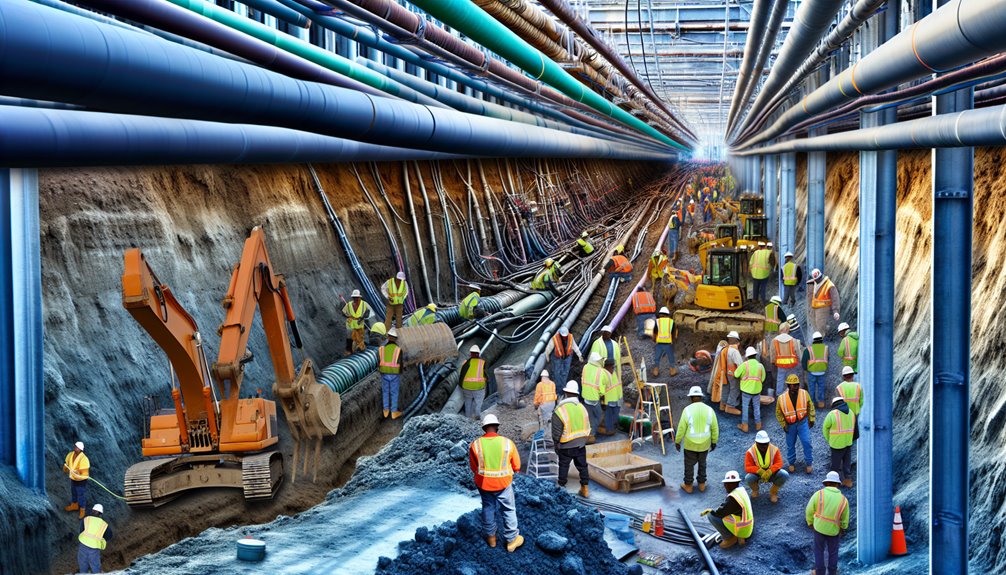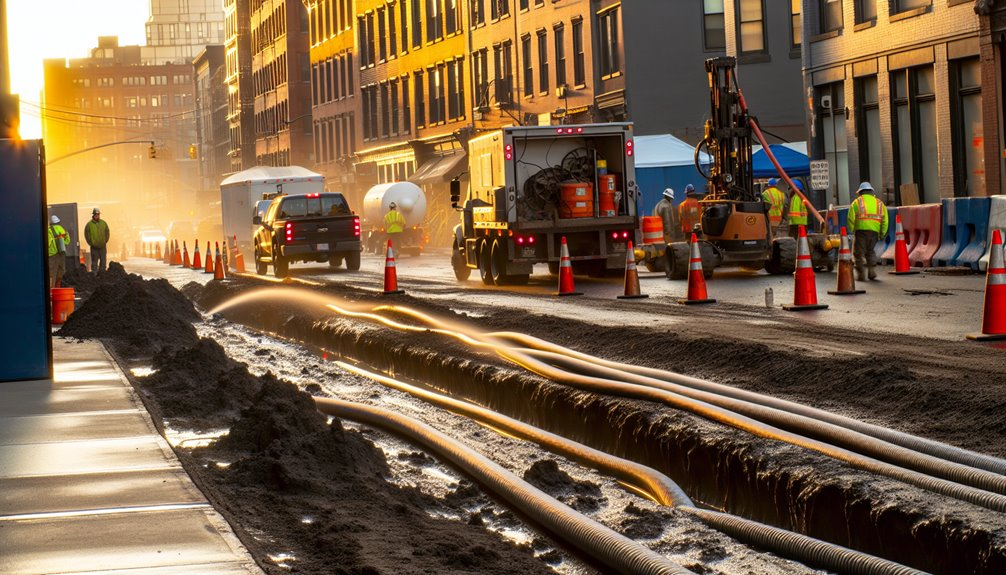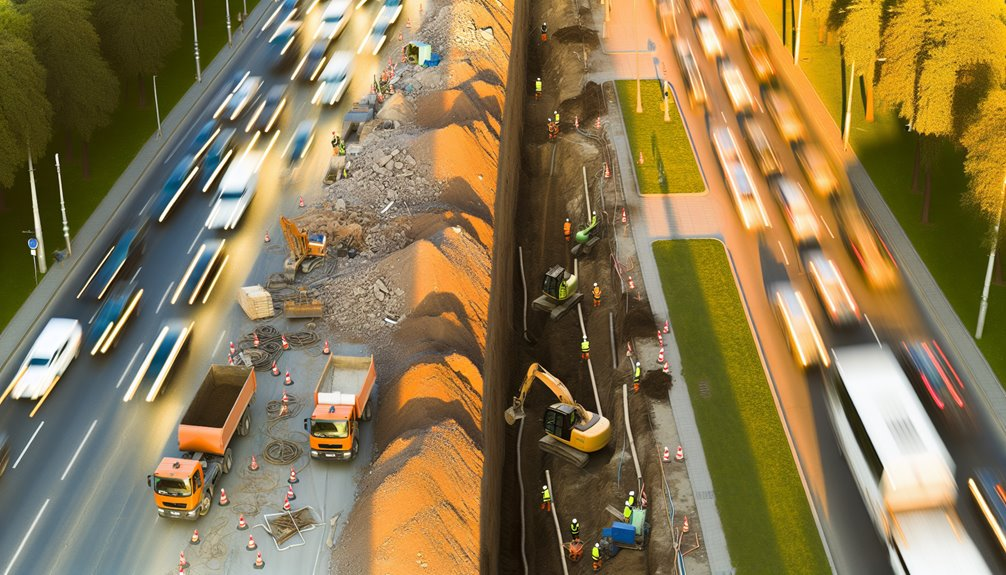When you commence an underground utility project, understanding the web of regulatory requirements is essential. You'll need to secure the right permits from local and federal bodies, ensuring full compliance with agencies like PHMSA. This not only safeguards your operations but also streamlines project timelines. Pay close attention to the details of environmental and safety standards; these will greatly influence your strategic planning. As you navigate these complex regulations, consider how mastering this aspect could enhance your project's efficiency and community impact.
Understanding the Basics of Underground Utility Construction
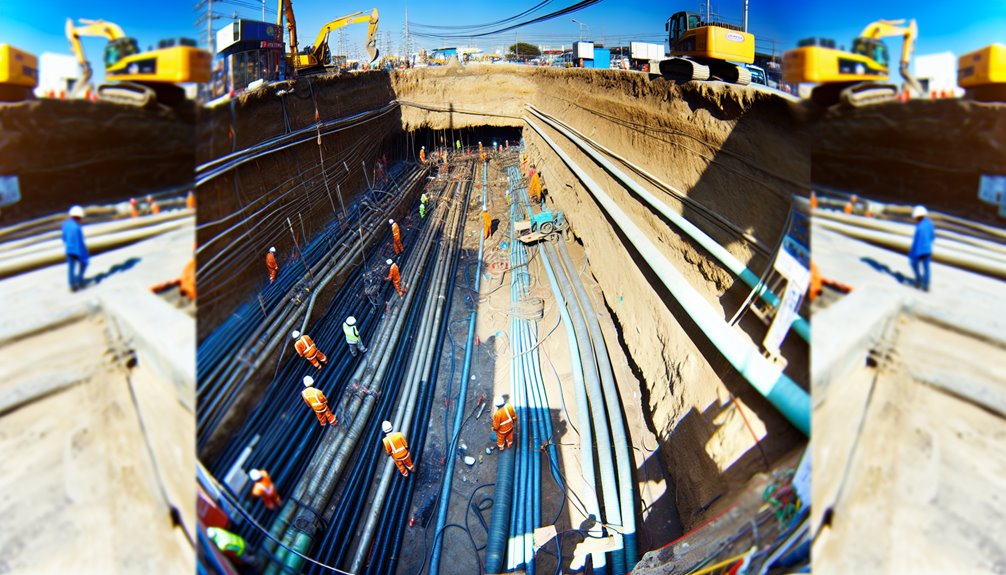
To comprehend the essentials of underground utility construction, you must first grasp its wide-ranging scope and diverse applications.
From urban centers to industrial complexes, the deployment of utility installation techniques is essential. Employing methods like trenching and horizontal directional drilling, you guarantee that vital services such as water, gas, and telecommunication are efficiently integrated into the infrastructure.
Focusing on trench safety practices is significant. As you plan and execute these installations, prioritizing trench stability and worker safety can't be overstated.
Techniques like shielding and shoring prevent collapses, while rigorous adherence to excavation standards minimizes risks. By embedding these practices, you not only comply with regulatory demands but also safeguard the integrity of your projects and personnel. This adherence ensures that potential hazards are proactively managed and regulatory compliance is maintained, supporting a safe working environment.
Key Regulatory Bodies and Their Roles
Understanding the roles of key regulatory bodies is essential when maneuvering the complex landscape of underground utility construction. PHMSA leads with strict mandates on pipeline safety and empowers state agencies to enforce these regulations, ensuring alignment with federal laws.
States must echo PHMSA's regulations, adding their own only if they don't conflict with national standards. This dual-layered governance forms a significant part of your compliance strategy, addressing various regulatory challenges effectively.
Local bodies like Public Service Commissions enforce specific regional laws, integrating with services like New York 811 to manage excavation notifications efficiently. Utility mapping is crucial for preventing accidental strikes on underground utilities, which these regulatory bodies emphasize to enhance safety during construction.
These efforts are vital in maintaining the delicate balance between operational efficiency and strict adherence to safety protocols, ultimately guiding your project to successful and compliant completion.
Overview of Essential Safety Standards
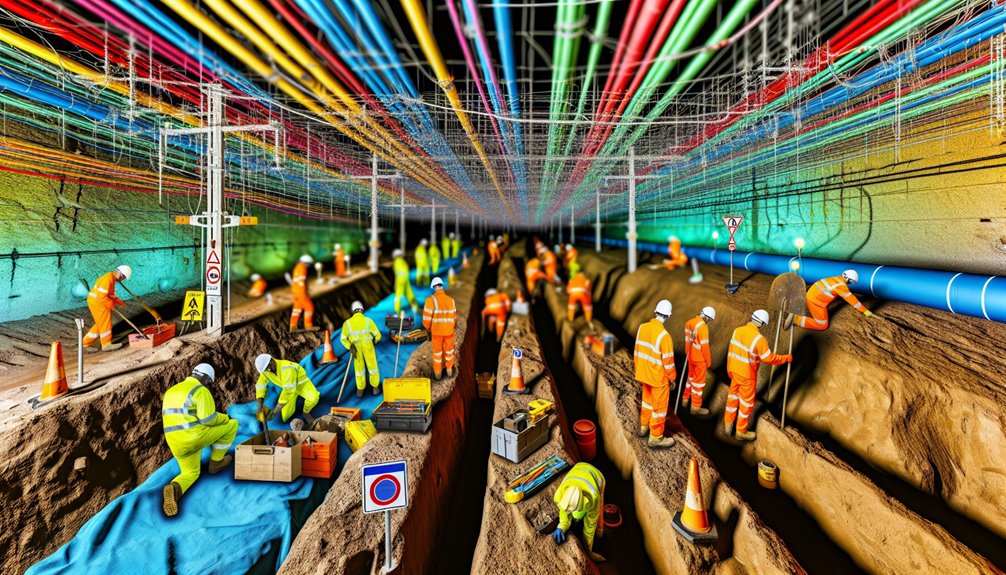
While maneuvering through the complexities of underground utility construction, adhering to essential safety standards is critical to protect both workers and infrastructure.
You must follow OSHA's guidelines for excavation, guaranteeing the location of underground utilities like sewer or electric lines is determined before digging commences. It's essential to prevent excavation hazards by contacting utility owners for markings.
For trench safety, prioritize the use of shielding and shoring to guarantee trench stability. Employ IoT technology for real-time monitoring of soil and air quality, enhancing safety measures.
Always maintain a clear understanding of the tolerance zones around marked utilities, using only prescribed methods within these zones to mitigate the risk of striking utility lines.
Environmental Considerations in Utility Projects
As you explore underground utility projects, considering the environmental impacts is essential. Implementing thorough environmental assessments guarantees you're aware of potential effects on natural habitats and local ecosystems. This proactive approach facilitates strategic planning and compliance with stringent regulatory frameworks, aiming to preserve the environment while advancing infrastructure development.
Key considerations include:
- EIA Process: Screening, scoping, and detailed reporting to identify significant environmental impacts.
- Habitat Preservation: Employing construction methods that minimize disruptions to wildlife habitats.
- Public Engagement: Integrating community feedback to enhance project acceptability and environmental stewardship.
- Regulatory Adherence: guaranteeing all activities comply with environmental laws and guidelines.
- Advanced Mitigation Techniques: Utilizing cutting-edge technology to prevent environmental damage and enhance precision in utility mapping.
Navigating Local vs. Federal Regulations
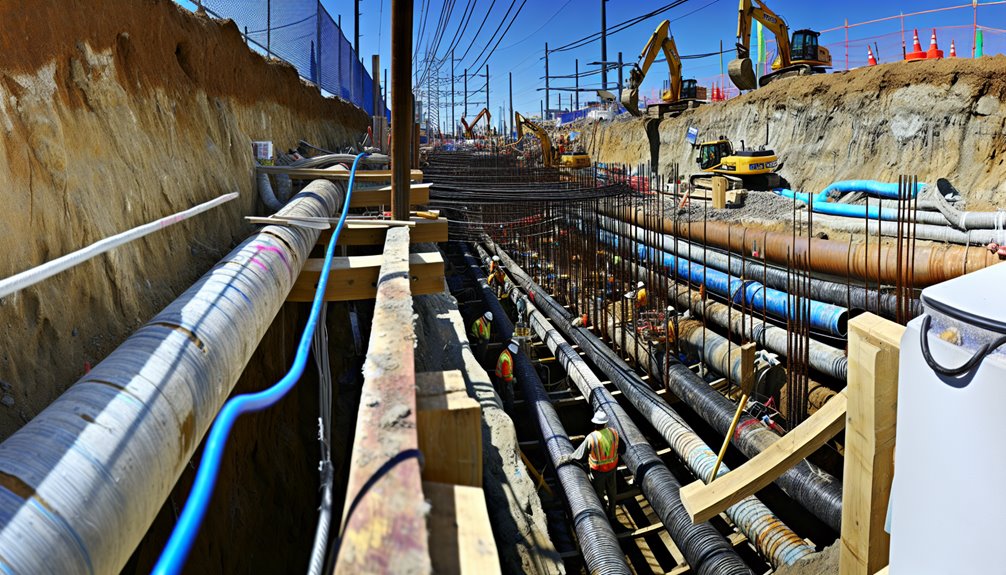
Steering through the complexities of local versus federal regulations is vital for the success of underground utility construction projects.
You'll find that local code compliance varies greatly across jurisdictions. For instance, cities like Chicago require specific permits and approval from entities such as the Office of Underground Coordination before moving forward.
On the federal level, leveraging federal funding mechanisms involves adhering to standards set by the Federal Highway Administration, especially if your project taps into federal-aid highway funds for subsurface utility engineering.
Understanding both spheres—local mandates and federal resources—is essential. You need to engage with local authorities early and navigate federal procedures meticulously to align your project with all regulatory requirements and optimize funding opportunities.
Permit Processes for Underground Construction
You'll first need to identify the various permits required for your underground construction project, including site development, land use, and specific engineering approvals.
Next, make sure you thoroughly understand the application submission steps, which involve collating utility records, conducting site inspections, and engaging in pre-application meetings with local agencies.
Finally, familiarize yourself with the approval timelines, as understanding these can greatly influence your project's scheduling and resource allocation.
Identifying Permit Necessities
Why do you need various permits for underground utility construction? Understanding permit types and application requirements is essential to guarantee compliance with diverse regulatory jurisdictions.
Here's what you need to take into account:
- Environmental Permits: Required for impacts on wetlands and waterbodies, including floodplain considerations.
- Non-Environmental Permits: Encompass land use and zoning adjustments.
- Engineering and Building Permits: Mandatory for deep excavations.
- Right-of-Way (ROW) Permits: Necessary for any encroachments on public or private land.
- Local DOT Authorizations: Needed for traffic management and surface restoration post-construction.
Securing these permits mitigates risks, avoids legal repercussions, and guarantees a smooth operational flow, aligning with both safety protocols and environmental stewardship in your innovative underground utility projects.
Application Submission Steps
Once you have prepared thoroughly, submitting your application for underground utility construction permits is the next critical step. Confirm your submission process adheres to stringent application requirements.
Start by providing detailed information about the work, including materials, specific locations, and dimensions from the centerline to the proposed area. Attach a clear sketch showing the state highway right of way and distances to side roads.
Include a cross-section drawing if the utility intersects pavement or structures, and provide GPS coordinates for start and stop points, bores, and location changes. A location map with precise directions to the site is essential.
This detailed approach not only streamlines the review process but also anticipates potential regulatory queries.
Approval Timelines Exploration
How long does it take to secure approval for your underground utility construction project? The timeline can vary considerably, influenced by several factors:
- Location and Complexity: Urban settings and complex projects typically extend approval times.
- Authority Workload: High volumes can delay processing times.
- Expedited Options: Additional fees might speed up the process.
- Stakeholder Coordination: Involvement of multiple agencies often complicates and prolongs the approval phases.
- Regulatory Compliance: Maneuvering through environmental and non-environmental permits requires meticulous planning.
You'll face numerous approval challenges, but with a focus on timeline optimization, you can streamline the process.
Efficient coordination and understanding regulatory nuances are key to accelerating your project's progress.
Impact of Utility Construction on Urban Planning
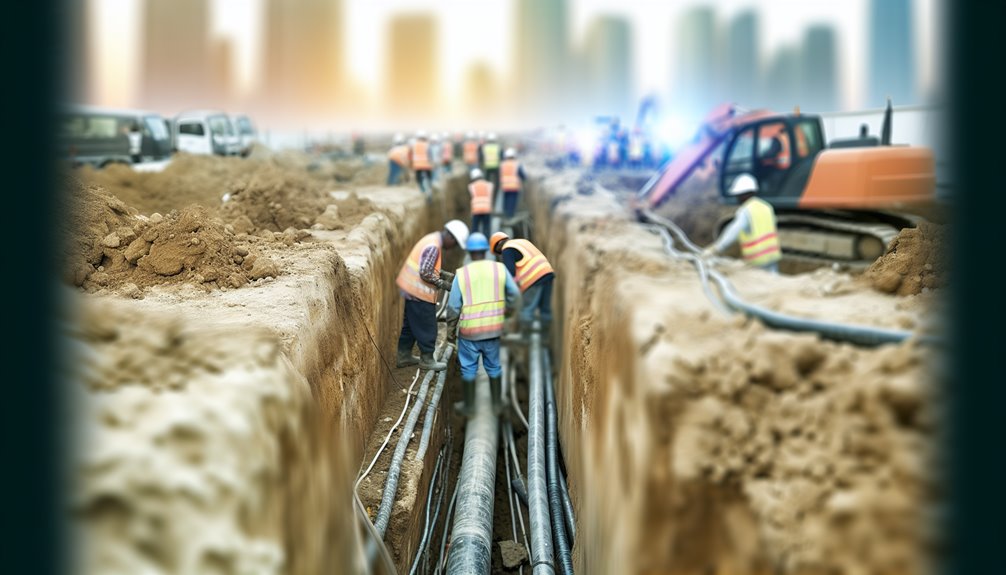
Given that utility construction lays the necessary foundation for community development, its integration with urban planning is essential to accommodate both current and future demands.
You must guarantee that infrastructure resilience is built into the planning phase to support sustainable expansion and mitigate risks associated with population growth and technological advancements.
Strategic alignment of utility installation with urban development plans not only enhances service delivery efficiency but also fosters community engagement by aligning with public expectations and needs.
It's critical you incorporate robust utility mapping and real-time data analytics to anticipate future requirements and prevent costly infrastructure conflicts.
This proactive approach in integrating utility construction within urban planning frameworks is key to developing smarter, more adaptive urban environments.
Strategies for Effective Stakeholder Communication
Effective communication with stakeholders is essential for the success of underground utility construction projects. You must focus on meticulous stakeholder engagement and develop sophisticated communication strategies. Here's how:
- Tailor Communications: Understand each stakeholder's specific needs and expectations to customize your messages.
- Use Diverse Tools: Employ a variety of communication tools like newsletters, community workshops, and digital platforms to reach different audiences.
- Maintain Transparency: Always keep stakeholders informed with updates and respond to their concerns promptly to build trust.
- Involve Stakeholders Actively: Encourage active participation through forums and hands-on activities, fostering a sense of project ownership.
- Highlight Benefits: Clearly articulate the long-term advantages and immediate impacts of the project to garner support and mitigate resistance.
These strategies are pivotal in maneuvering the regulatory landscape of underground utility construction.
Managing Risk and Ensuring Compliance
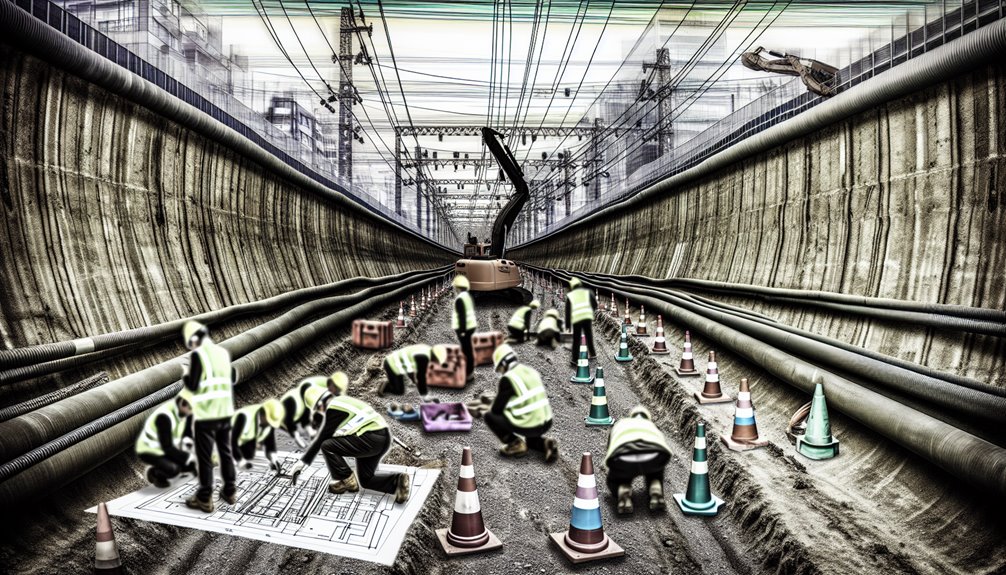
After establishing robust communication strategies with stakeholders, attention must now turn to managing risk and guaranteeing compliance in underground utility construction.
You'll prioritize risk assessment throughout your project phases to address potential safety, financial, and environmental challenges. Focus on compliance audits to verify adherence to stringent regulations governing worker and public safety, environmental protection, and project management.
Develop and regularly update safety protocols and emergency response strategies to mitigate risks of injuries and accidents. Ascertain your team undergoes thorough safety training and maintains essential insurance coverage.
In addition, align your operations with industry standards and regularly engage with regulatory bodies to preempt compliance issues and manage the regulatory landscape proactively. This approach not only safeguards your project but also enhances its credibility and viability.
Technological Innovations in Regulatory Management
As you navigate the complexities of underground utility construction, it's essential to integrate smart compliance software solutions that streamline regulatory adherence.
These platforms leverage AI-driven permitting processes, ensuring that you're obtaining necessary approvals efficiently and accurately.
This technological approach not only saves time but also greatly reduces the likelihood of compliance-related issues that can disrupt project timelines.
Smart Compliance Software Solutions
To streamline regulatory compliance in underground utility construction, smart compliance software solutions automate essential processes.
Here's how these innovative tools can notably benefit your projects:
- Automate Compliance Tasks: Considerably reduce manual work and errors, guaranteeing consistent adherence to standards like the National Construction Code.
- Real-Time Data Integration: Offers instant access to compliance status updates, enhancing decision-making and stakeholder collaboration.
- Centralized Documentation: Keeps all compliance documents in one place, accessible to everyone involved, anytime.
- Detailed Reporting: Generates thorough reports that track compliance progress and spotlight areas needing attention.
- Technology Integration: Seamlessly connects with other technologies such as BIM and digital twins to provide a unified view of project compliance.
Leveraging these features in your construction software guarantees you're not just meeting but exceeding regulatory standards.
AI-Driven Permitting Processes
While AI-driven permitting processes are revolutionizing underground utility construction, they bring unparalleled precision and efficiency to permitting.
Leveraging AI automation, you can now harness predictive analytics to anticipate material demands and streamline resource allocation, guaranteeing that permits are granted without delays due to unforeseen shortages.
Furthermore, data accuracy is greatly enhanced, as AI-powered tools meticulously analyze vast datasets, from soil conditions to equipment locations, optimizing every facet of the permitting process.
This meticulous approach not only secures compliance with stringent regulatory standards but also minimizes the risk of costly project delays.
Embrace these AI advancements to guarantee your projects aren't only compliant but also set benchmarks in efficiency and safety.
Conclusion
As you navigate the complex landscape of underground utility construction, it's essential to stay ahead of regulatory demands. Make certain you're aligning with both local and federal guidelines, securing necessary permits early, and leveraging technology for compliance. By maintaining open communication with stakeholders and prioritizing environmental safeguards, you'll manage risks more effectively and uphold safety standards. Remember, your adherence to these regulations not only guarantees legal compliance but also enhances community trust and project success.
If you're looking for more insights or need assistance with your underground utility projects, I invite you to visit Boring Bros at boringbro.com or give us a call at (954) 639-6167. We're here to help you navigate the regulatory landscape and ensure your projects are successful. Don't hesitate to reach out—we'd love to connect with you!

